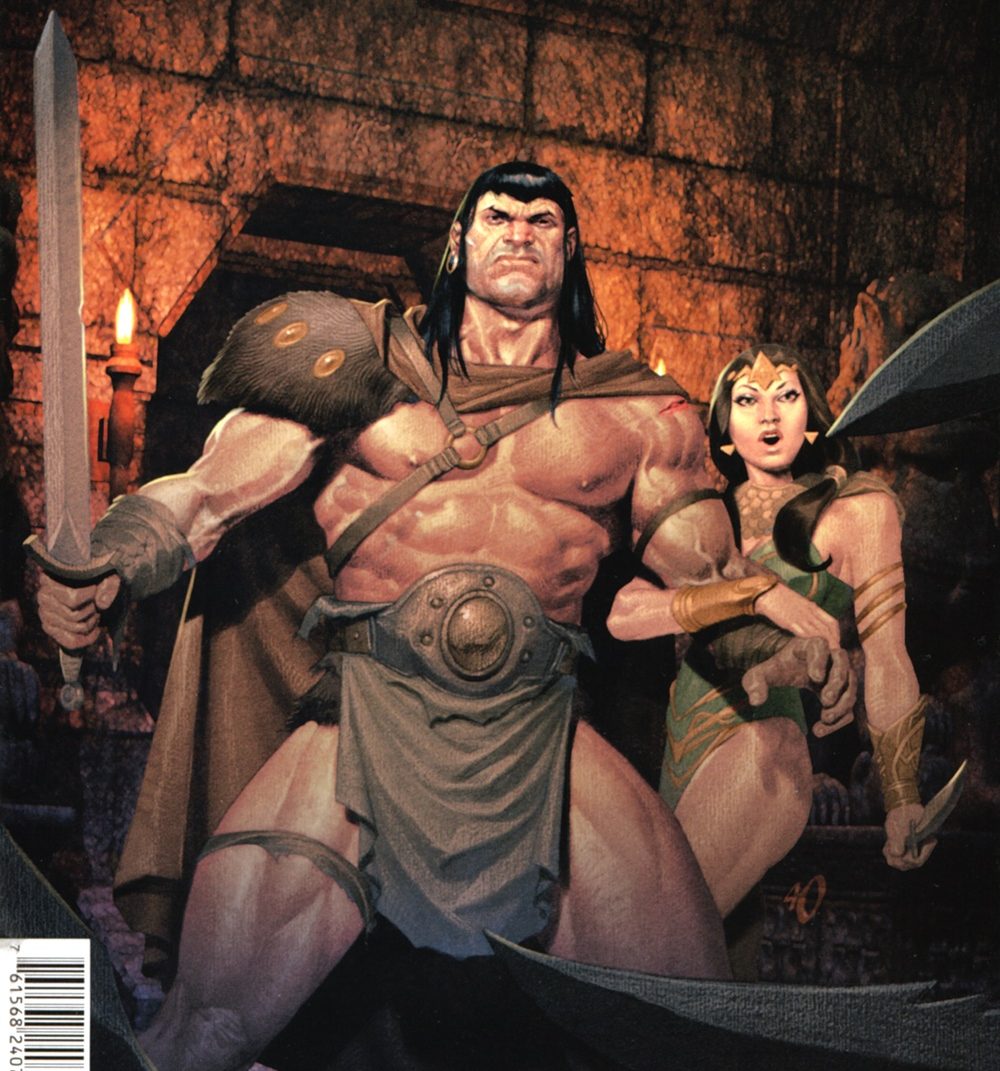Conan: The People of the Black Circle
The People of the Black Circle was published first published in Weird Tales magazine in three parts over the September, October and November 1934 issues. It is the twelfth published story in the Conan canon.
The first installment appeared one month after Devil in Iron, the previous story. Readers during the fall of 1934 enjoyed a continual diet of Conan yarns.
This is also the first novel-length outing for Conan, and one of Howard’s better efforts (albeit even his worst are better than many a man’s best).
There are sorcerers aplenty among the unearthly menaces in various Conan tales up until now: Thoth-amon in Phoenix on the Sword, Tsotha in The Scarlet Citadel, Yara in Tower of the Elephant, Thugra Khotan in The Black Colossus: but here Conan invades the Black Seers of Yimsha, who are the Roke or the Hogwarts of the Hyborian Age.
He therefore runs afoul not of one warlock or necromancer, but of a whole organization of students and masters of the Dark Arts, and he storms their eerie haunted fortress behind its moat of venomous mists at the climax.
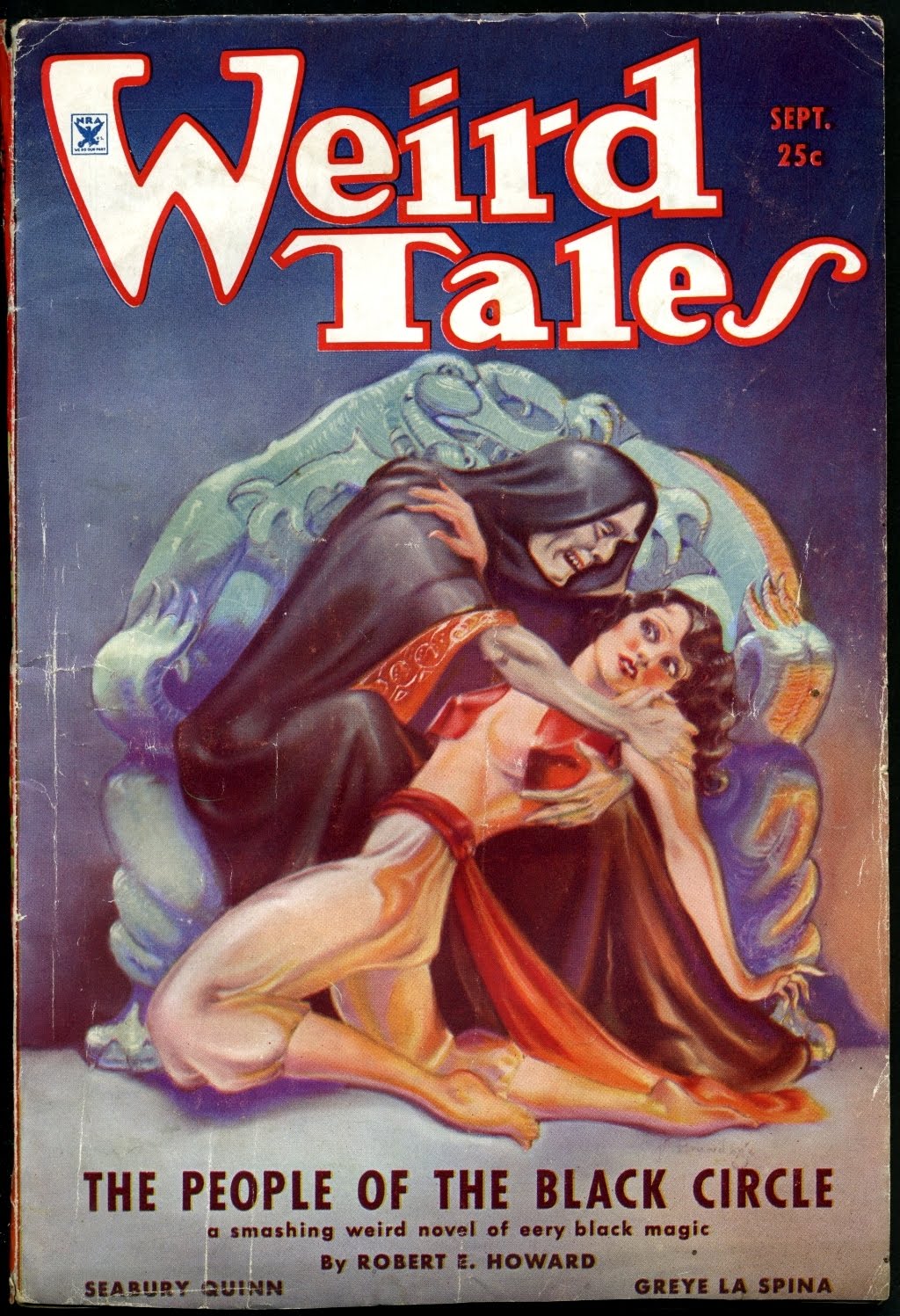
This yarn truly merits the nickname later invented by Fritz Leiber for the genre of Sword and Sorcery. There is a more sword and a lot more sorcery than any Conan story to date.
The energy and action, the clash of steel on steel, so evident in his shorter works, here loose no tension on the larger canvass. Some authors who show admirable economy in the short story betray a lack of discipline in their novels, indulging in digression and needless ornament. Not so here. The rapidfire pace the Conan reader has come to expect is maintained.
The prime thing that makes his yarn memorable is not, however, the swordplay or even the sorcery, both of which are done well, but the minor characters of Khemsa and Gitara: their tragic love story is moving, even though the pair are villain and villainess of the blackest hearts of the most undiluted and purest quill.
Artist Ariel Olivetti paints a memorable impression of the red-turbaned black-cloaked Masters of Yimsha in the very faithful Dark Horse comic adaptation.
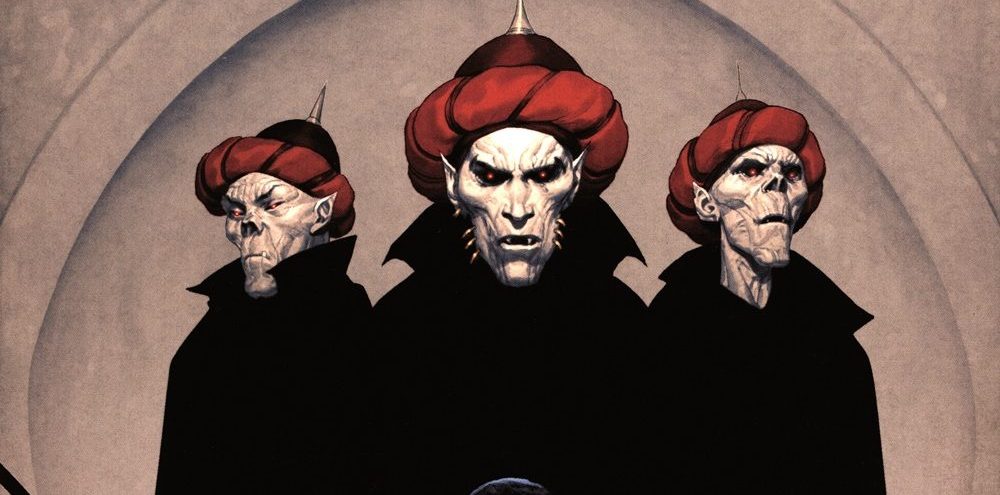
It should be noted that nearly every Conan story is set against a rather convoluted political situation, and even otherwise simple tales about pirates often involve a mention of factions or mixed loyalties. This brings out the contrast with Conan’s simple loyalties: he never betrays friends or comrades, even if casually met. His brutal straightforwardness is a refreshing contrast to the intricate schemes of betrayal and subterfuge characterizing his antagonists.
In effect, every character has good reason to hate and fear nearly every other. Conflict rages, and this being a swashbuckling eon, all conflicts are resolved by abductions, assassinations, ambushes, bloodshed and black magic. Good times!
The main conflict in the backdrop is the ongoing rivalry between the kingdom of Turan (Turkey) and Vendhya (India). The sultan of Turan, king Yezdigerd, has called upon the secret society of Black Seers, who occupy the upper echelons of the priesthood in his nation, to steal the soul of the maharajah of Vendhya, Bhunda Chand, via black magic out from his body, imprisoning his spirit and snapping the silver thread of life, thus damning him alive to hell.
To this end, the king of Turan sends a nobleman called Kerim Shah (we never learn his real name) to smuggle the sorcerer-assassin Khemsa, an acolyte of the Black Seers, into the Vendhya capital to work his dark arts.
The central conceit of all Hyborian Age stories is that just beyond the reach of recorded history, nations and empires now forgotten thrived in the lands now flooded with the Mediterranean sea, when Europe, Asia and Africa were one continent. The technology and military hardware ranged from neolithic to late medieval, but all that is recalled of this vanished era are a few names of lands now mythical, or old gods later called devils.
This allows Howard the simple but clever sleight of hand of substituting a prehistoric version for any picturesque or exotic land that strikes his fancy, keeping the local color of weapons, costumes, customs and names, while indulging in anachronism readers of historical romances tolerate only in small amounts.
A reader of historic romance might raise an eyebrow at a Fourth Century Celtic warlord leading Twelfth Century Afghani hillmen kidnapping a Third Century Hindu princess from India while fencing Tenth Century Turks and evil Buddhist monks in the Himalayan mountains of Tibet, but no reader of a prehistoric romance taking place in antediluvian lands can object to a Cimmerian warlord leading Afghulis kidnapping a Vendhya princess while fencing Turanians and evil seers in the Himelian Mountains of Yimsha.
The tale opens with the triumph of Khemsa: a stolen lock of hair, combined with the conjunction of adverse stars, allows Bhunda Chand to be afflicted unto death. As he twists in his dying throes, Bunda Chand rouses himself to lucidity long enough to name his phantom murderers and to command his royal sister, the Devi Yasmina, to slay him swiftly, that he may die with his spirit unstained.
In tears, the royal princess does the necessary deed. Bunda Chand perishes with a grim smile on his lips.
The sorcerer Khemsa remarks wryly to the noble swordsman Kerim Shah, “My masters are greater than yours, for they have accomplished by their arts what Yezdigerd could not with a hundred thousand swords.”
So, in terms of swords and sorcery, sorcery at first has more right to boast.
The second conflict is introduced in chapter two: a strange barbarian from the west has seized leadership of several bands of not-quite-Afghan bandits in the northernmost province of not-quite-India, and the brigands have grown bold and dangerous. Seven hillmen chiefs, his lieutenants, however, were recently captured, and are due to be hanged.
The Devi and her maid, Gitara, travel alone and in secret to visit by night the governor of the province, who is horrified at the risk her highness has taken by coming to this wild frontier area.
She explains:
“The king of Vendhya was destroyed by magic,” she said at last. “I have devoted my life to the destruction of his murderers. As he died he gave me a clue, and I have followed it. I have read the Book of Skelos, and talked with nameless hermits in the caves below Jhelai. I learned how, and by whom, he was destroyed. His enemies were the Black Seers of Mount Yimsha.”
Yasmina commands the seven chieftains to be kept alive as hostages: For it seems the Devi wants to force the foreign leader to slay her occult enemies.
This bold and dangerous foreign leader, of course, is Conan.
Why him? His bandit hillmen control the passes leading to the desolate mountain peak of Yimsha, which the Rakhshas of Black Seers haunt, and could block or destroy any army she sent. The hillmen might fear the Black Seers, but Conan is known to fear nothing.
It goes without saying that Yasmina is drop-dead gorgeous, by the bye.
It was a woman who had entered unannounced, a woman whose gossamer robes did not conceal the rich garments beneath them any more than they concealed the suppleness and beauty of her tall, slender figure. A filmy veil fell below her breasts, supported by a flowing head-dress bound about with a triple gold braid and adorned with a golden crescent.
Conan is as willful and unexpected as Yasmina, for he also arrives, like her, unannounced by night in the governor’s chambers, having climbed past guard and over wall, roof and tower, and into his window like some silent hunting cat of the jungle.
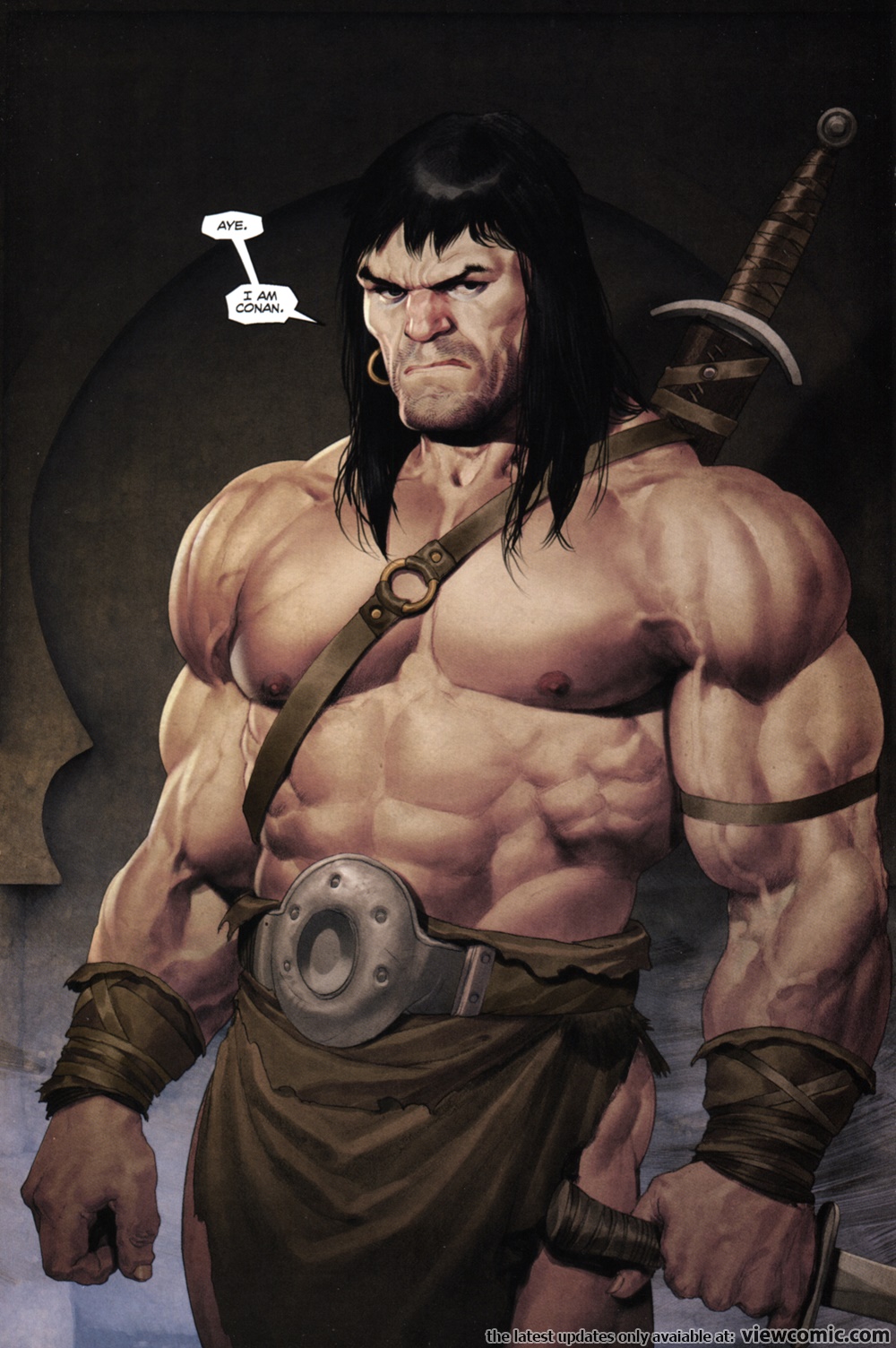
Awesome pic of Conan, courtesy of Ariel Olivetti DARK HORSE Comics
Tense negotiations between the governor and Conan are interrupted when the Devi in her filmy silk garments enters the chamber, and her identity is accidentally revealed. The barbarian, as any healthy barbarian would, abducts the girl by hoisting her on his shoulder and leaping out a window.
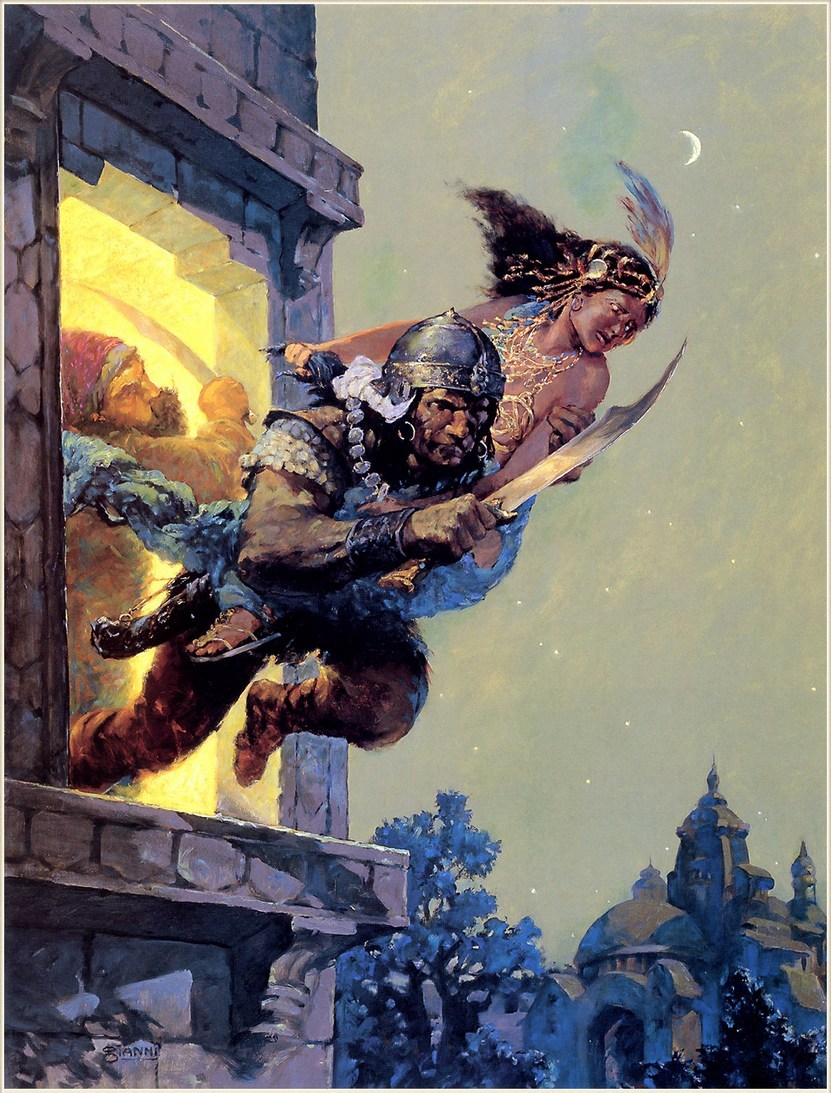
Conan’s plan is simple: the governor will not dare hang the seven hetmen while the princess is in his hands. Conan, that hill-bred dog, races away into the night with the shapely princess flung over his saddlebow, and the entire cavalry of the fortress in hot pursuit.
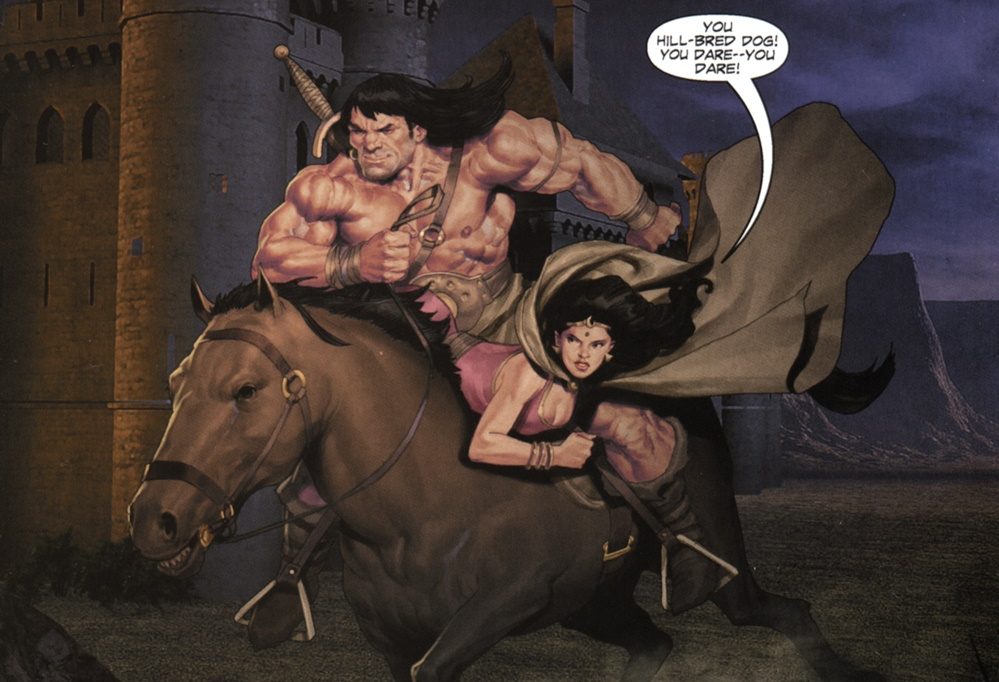
In the next chapter, now comes the plot twist that turns the story from good to great, and lifts it above the average adventure yarn:
Gitara, the fair handmaiden of the fair princess, upon learning of the abduction, slips unseen from the fortress, and runs across field and slope, leaping irrigation ditches like a trained athlete to the nearby city. She meets with Khemsa the sorcerer on the roof of a dark house.
It is revealed that Khemsa broke the laws of his austere order, and the girl is his lover.
Gitara, panting, her dark eyes blazing, winds her shapely arms about his neck, and urges him to use this turn of events for his own benefit, and hers.
“I will make a king of you! For love of you I betrayed my mistress; for love of me betray your masters! Why fear the Black Seers? By your love for me you have broken one of their laws already! Break the rest! You are as strong as they!”
Ironically, as we shall see later, her words are true. She urges him to steal Yasmina back from Conan, ransom her for unimaginable wealth from the not-quite-Indians, sell her to the not-quite-Turks, and use the loot to make an empire of their own.
Khemsa agrees: but when she silently urges him to slay Kerim Shah asleep on his couch, even his villainous heart cannot brook a violation of the guest law:
“I have eaten his salt,” he muttered. “Besides, he can not interfere with us.”
After they depart, Kerim Shah, who was not asleep after all, wryly comments: “People who plot on roofs should remember to lower their voices.”
He immediately sends a message by carrier pigeon to the nearest Turanian garrison, commanding a brigade of horsemen to rendezvous with him and his allies, the Irakzai tribe, that their own pursuit to abduct the princess might commence. For it seems the king Yezdigerd not only desires the crown of Vendhya for his brow, he also craves its princess for his harem.
To prevent the possibility of Conan exchanging the princess for his seven chiefs, Khemsa the sorcerer walks boldly into the fortress where they are kept to slay them.
One would almost think Khemsa were the hero of this story, because in this scene, he is a total badass.
Khemsa mesmerizes one spearman on guard, forcing him to commit suicide. Another spearman he casually disarms as one might flick aside a straw, and breaks his neck with a brush of his hand. The gate he blasts from its hinges merely by putting his palm to the massive wooden planks. He conjures a cloud of poisonous gas to smother the seven prisoners, forcing them to die in silence by the terror of his hypnotic eyes. Throughout all this, Khemsa neither raises his voice, nor makes a sound, nor breaks a sweat.
He calls down a cloud to carry them to the mountains.
“And now for a steed swifter than the fastest horse ever bred in a mortal stable,” Khemsa was saying. “We will be in Afghulistan before dawn.”
You might be wondering, dear reader, why I praise this turn of the plot. All I can say is that I have red a plethora of adventure stories both pulp and slick, science fiction and fantasy. I cannot recall even one where the henchman rebelled against his masters while remaining an unrepentant bad guy and a stone cold killer: and did it for love.
In chapter four, yet another conflict rears into view.
Here, I mean not just the emotional conflict in the heart of Yasmina. She is, of course, sexually allured against her will to the brawny, broad-shouldered, and virile masculine male who has abducted her, and who defends her life from danger and terror with his muscles of iron and his brooding eyes with their iron willed glances. And he is also a rebel who plays by his own rules. Chicks are attracted to bad boys. This is just a fact of life: make of it what you will. Did I mention the brooding eyes?
When Conan returns by night to the brigands he rules, the Kshatriya cavalry of not-quite-India hot at his heels, he find that, as he feared, his inability to recover the seven chieftains unharmed have turned hearts against him, and now daggers are out, seeking his life.
Escaping the pursuing cavalry in the dark, the canny hillmen flee to a village hidden in the rocky crags, but not without being spotted by the Irakzai allies of Kerim Shah, who go to summon the horsemen of Turan to the chase.
The next morning, Conan’s life is menaced by his mutinous bandits, angered that Conan has brought the wrath of the Kshatriya down on them, but hetman Yar Afzal (whose life Conan previously saved) is there to cow his rebellious men to silence with threats and curses.
During the discussion, it is revealed that Conan knows Kerim Shah’s real name and race, and knows him to be a spy for the king of Turan. They are old foes, and Conan promises to hang his hide to a bush.
In case you are losing count of the tensions, hatred, and conflicts involved, let us count: King Yezdigerd and his agent Kerim Shah has King Bhunda Chand assassinated by the Black Seers through their student, Khemsa; so Yasmina vows vendetta against the Black Seers; and she holds Afghuli chieftains hostage to force Conan to be her mercenary; but he kidnaps her instead as hostage to free the seven; who meanwhile are slain by Khemsa at the passionate urging of his lover, Yasmina’s treasonous handmaiden, Gitara, thus betraying his masters; which also betrays Kerim Shah, whom Khemsa unexpectedly spares; who in turn gathers horsemen to slaughter Afghulis while hunting for Yasmina; while her own horsemen are likewise conducting a search, slaughtering hillmen as they do; rousing the enmity of the tribesmen against Conan, held in check, for one night, by the authority and awe of Yar Afzal; and Conan also has a personal grudge against Kerim Shah.
In sum, each character is in deadly conflict with each other, save for those loyal unto death and even beyond: Yar Afzal to Conan, Yasmina to her brother, Khemsa and Gitara.
All these tensions now collide and explode together, one domino toppling another, as ambition and revenge break into bloodshed.
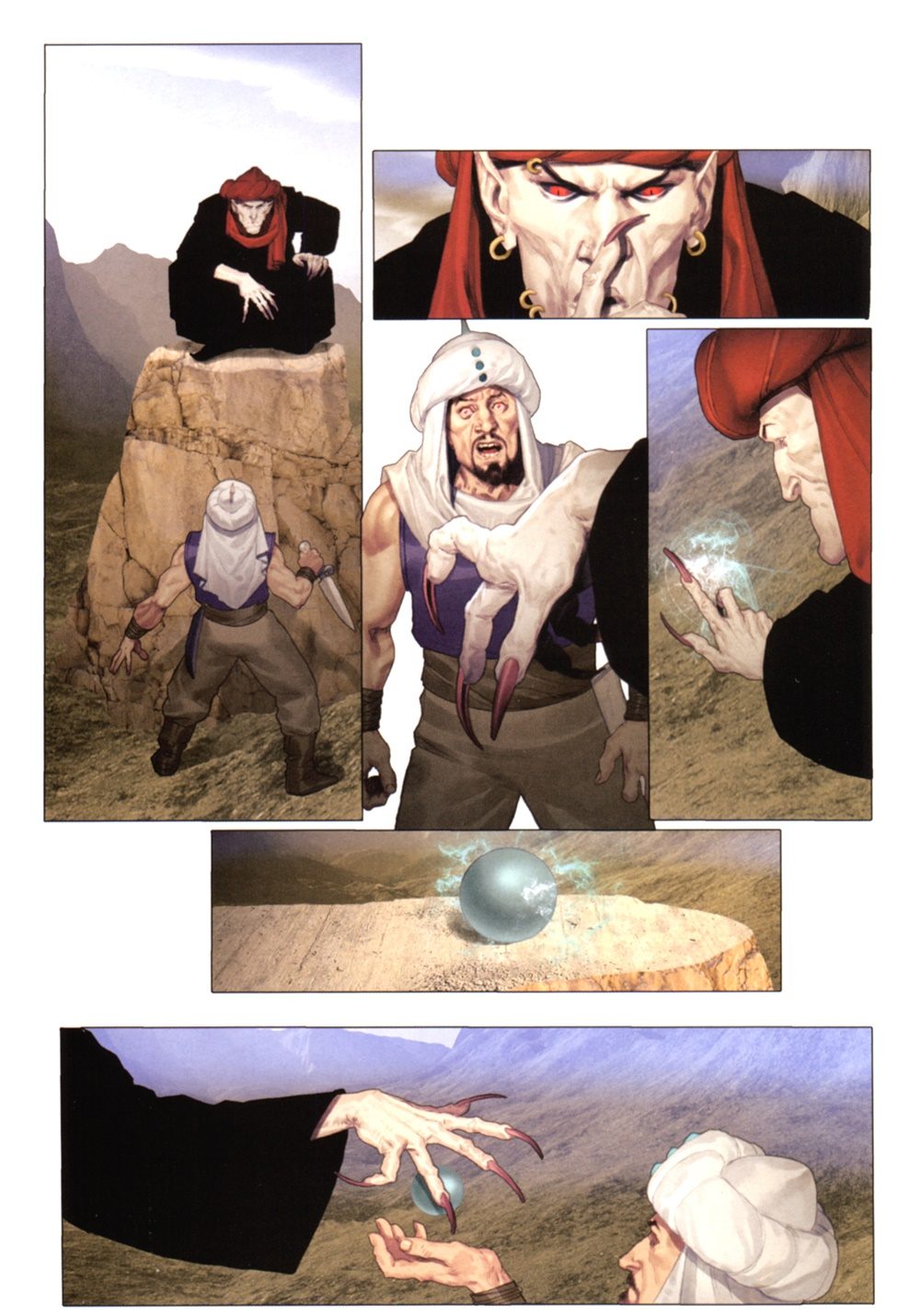
The snowball of bloodshed starts with a minor character never even given a name. Yar Afzal bullies his followers into cringing obedience. One boastful, humiliated bandit is mocked by the womenfolk of the village and sent cringing away. He encounters Khemsa the sorcerer calmly seated on a rock, but he gazes into his magnetic eyes and is lost before he can cry out.
Through his helpless puppet, Khemsa assassinates Yar Afzal, and frames Conan. Conan is cornered by a howling horde of wrathful cutthroats in the stronghouse of the Yar Afzal, making his escape by way of a hidden backdoor and magnificent black stallion. He seizes the girl and flees, almost trampling Khemsa in the mad gallop.
Outdistancing pursuit, Conan buys the garments off the back of a passing peasant girl which he forces the princess to wear, but he does not look when she changes.
It will seem odd to the modern reader, who perhaps is used to scenes of rape and incest in their grim and dark sword and sorcery stories about throne of blades and vampire-haunting winters coming, that Conan, for all his barbarous background, displays chivalry at least of a rude sort when it comes to women.
Less chivalrously, as he compliments her on the new apparel, the barbarian playfully swats her on her pert buttocks.
I am sure most reigning female monarchs, such as Queen Victoria, would find such behavior too familiar, but, in this case, our brutally handsome barbarian is the archetype of all untamed caveman bad boys of female daydream.
It is doubtful whether the modern reader would sympathize either with the respect for female modesty displayed by averting one’s eyes, nor with the outrageous masculine confidence displayed by the swat. Few moderns have seen or can image modest femininity or outrageous masculinity. Our generation has liberated sexuality to the point where nothing is sexy.
In any case, the writer who comes from a time before the basic truths about men and women were forbidden, is adroit enough adumbrate the kindred spirit between him and Princess Yasmina, so her attraction to him is not as arbitrary as one might think. More on that later.
Khemsa, with Gitara, whirled by unholy, unseen wings through the air, waits on a ledge for Conan and Yasmina. Without a word, the deadly duel begins. Khemsa by the mere glare of his evil eye, makes the mighty barbarian stagger.
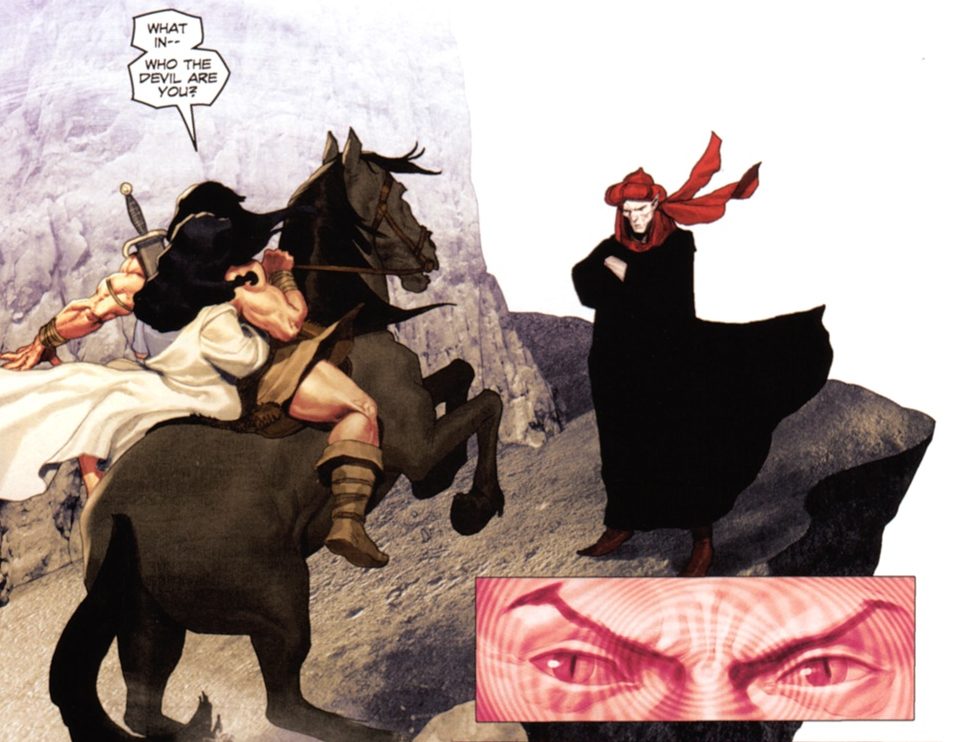
An interesting passage crops up in the description of the encounter:
Khemsa’s sorcery was based on hypnotism, as is the case with most Eastern magic. The way has been prepared for the hypnotist for untold centuries of generations who have lived and died in the firm conviction of the reality and power of hypnotism, building up, by mass thought and practise, a colossal though intangible atmosphere against which the individual, steeped in the traditions of the land, finds himself helpless.
But Conan was not a son of the East. Its traditions were meaningless to him; he was the product of an utterly alien atmosphere. Hypnotism was not even a myth in Cimmeria. The heritage that prepared a native of the East for submission to the mesmerist was not his.
Khemsa, loosing confidence in his magic and therefore losing part of his power to work it, resorts to other means: Khemsa is a bad-ass, and fells Conan with a flick of his hand. He knows what might be illusion, might be antediluvian kung-fu, described as “… a cruel art forgotten of men before Atlantis sank [which] would have broken like a rotten twig the neck of a lesser man.”
Conan is a badder ass, and slashes at the sorcerer-assassin even as he falls, forcing Khemsa to bound backward in a fashion the author calls “most unwizardly.”
Note that an explanation on the inner psychological workings of magic is something unknown in fairy tales and folklores, therefore out of place in modern fantasy works following those conventions. Nor does this sound like the sound engineering explanation science fiction reader expect. Instead the explanation has that mood characteristic of Weird Tale or a Lovecraftian yarn, which has an atmosphere as pseudo-scientific and spooky, hoary and eldritch as Lost Continent of Atlantis itself.
I do not say that the scent of such fringe science spookiness is not from time from time caught in pages of fantasy and science fiction. The borders between the realms of these three genres are unguarded; artistic inspiration, as does the wind, blows wither it listeth. But I do say it is the native atmosphere of the Weird Tale.
Things are going badly for Conan when interruption comes.
Four of the dark Masters arrive in a fiery cloud, and engage the traitor to their order, Khemsa, in an duel of unseen spiritual forces. Gitara’s prophetic words praising her lover to be a potent as all his masters turn out to be true, and also to be a self fulfilling prophecy: for her faith in him and burning love make him strong enough to throw back the evil gazes of the arch-magicians.
Tragedy strikes! The dark masters see the source of Khemsa’s spiritual strength, and bend their amassed sinister willpower on the untrained and unprotected brain of the girl. Gitara is mesmerized and flings herself from the cliffside to her grisly death. Thunderstruck by grief, Khemsa’s iron willpower faulters. One of the dark masters, with a casual stomp of his foot, conjures a landslide, breaking the ledge underfoot, and sending Khemsa plunging in an avalanche down into the abyss.
The fiery cloud now scoops up Yasmina, and the magicians vanish into the air. Conan is left helpless and stunned on the cliff. Conan vows to recover the girl, and heads toward the forbidden mountain peak which is their lair.
In the second most magnificantly badass scene in the whole Conan cannon, Conan comes across the broken remnants of the body of Khemsa: and the body is still moving.
The sorcerer assassin should be dead, but keeps himself alive by sheer willpower and scalding hate, has climbed back up from the rocky abyss, his every bone broken, his eyes still hot for revenge. The enemy of an enemy is a friend: with his dying breath, he tells Conan the secret of approaching the terror-guarded citadel of the dark masters, and the means to overcome them.
His last words:
“I am going to Gitara—she is waiting for me in hell—aie, ya Skelos yar!” And so he died.
Like the affection of Wesley for Buttercup, this is true love. It does not happen every day.
Conan is riding toward the forbidden mountain when he encounters his old enemy, Kerim Shah, leading a troop of native mercinaries of the Irakzai tribe, who, if you recall, are the deadly enemies of the Wazuli tribe, who are now the deadly enemies of Conan, and who are also closing in.
After a brief scuffle at knifepoint, and exchanges of threats and insults, Kerim Shah, whose mission is the abduction of the Devi rather than the death of Conan, decrees a temporary alliance of convenience with Conan against the Dark Masters.
Rather than cutting Conan to bits, and then being cut to bits in turn by disgruntled Wazulis robbed of their own chance to cut Conan to bits, the Irakzai mercenaries decide to follow Kerim Shah.
What follows is, at least to my limited knowledge, the first ever published running fight scene with, not one evil wizard or two, but an entire school of the sinister creatures.
I have spoiled many a surprise in my overlong and overly detailed recap of the plot: now I lay my hand over my mouth and give away no more details.
I will, however, make the comment that all fantasy writers realize whenever they first pen a scene where magicians have a central, active role.
In a fairy tale, magic traditionally plays no other role than to establish the main obstacle. The witch utters the curse that poisons an apple or the spindle of a spinning wheel, or casts a charm to change crewmen to swine. Such magic is covert, that is, the workings or the limits of the magic need not be onstage.
In a story of the traditional sort, the limits of magic do not matter, because the question of what else Circe or Malificent could do if need be never comes up.
If Cinderella is told she must return from the ball by the last stroke of midnight, this sets a limit, and the fact that the fairy godmother does not explain why leaves the matter mysterious. Nor does anyone explain why the fairy godmother makes a carriage from a pumpkin, even if we all somehow instinctively know it should be that way. Likewise, if a vampire can be driven back by the sight of the crusifix, or if Koschei the Deathless can only be slain by smashing an egg hidden in a buried chest on a remote island, no further explaination is needed.
These things seem like they fit the rules of magic, even if we have no anthropologist or parapsychologist at hand to explain those rules explicitly.
But in a story where the magician comes onstage as an active character, reacting immediately to what opponants do, where the magician calls on magic to fight a battle or solve a problem, the reader has to have a sense of what the magician can do and cannot do. If the magic can do anything whatever, as, for example, the magic of the genii in the old Saturday morning cartoon SHAZZAN, there is no fear of failure hence no reward for success.
Overt magic can do only limited things, and those limits have to be explained and defined. However, this risks robbing the magic of its mystery and of its haunting aura of the unknown and half-unseen. If magic is systematized, it becomes too much like a legal code or technology, and magic is robbed of magic.
A cunning write can avoid these twin pitfalls by setting limits to magic redolent of older tales, which the reader grasps more by instinct than by study. They feel right. Such limits fit neatly with the unspoken expectations of the reader, and the workings of magic will seem fitting, even if the rule is not laid out so blatantly as to rob the magic of its wonder.
In this case, if the four dark masters have their lives hidden in a fragile object just as the life of Koschei the Deathless was hidden in an egg, it feels right.
So a battle between wizards and tribal mountain bandits lead by a barbarian warlord errupts. The magic is sly, deceptive, devilish, and unwholesome.
Mad dogs, maneating hawks, a moat filled with choking mists, the poisoned fang of an illusionary asp, or ground hugging clouds of St. Elmo’s fire are the preferred weapons of the acolytes; suicide imposed by irresistible mesmeric gazes is used by the masters; the grandmaster merely rips the beating heart of his foe straight through his ribcage at twenty paces. And of course Conan wrestles an oversized snake. What else can one expect in a wizard’s castle?
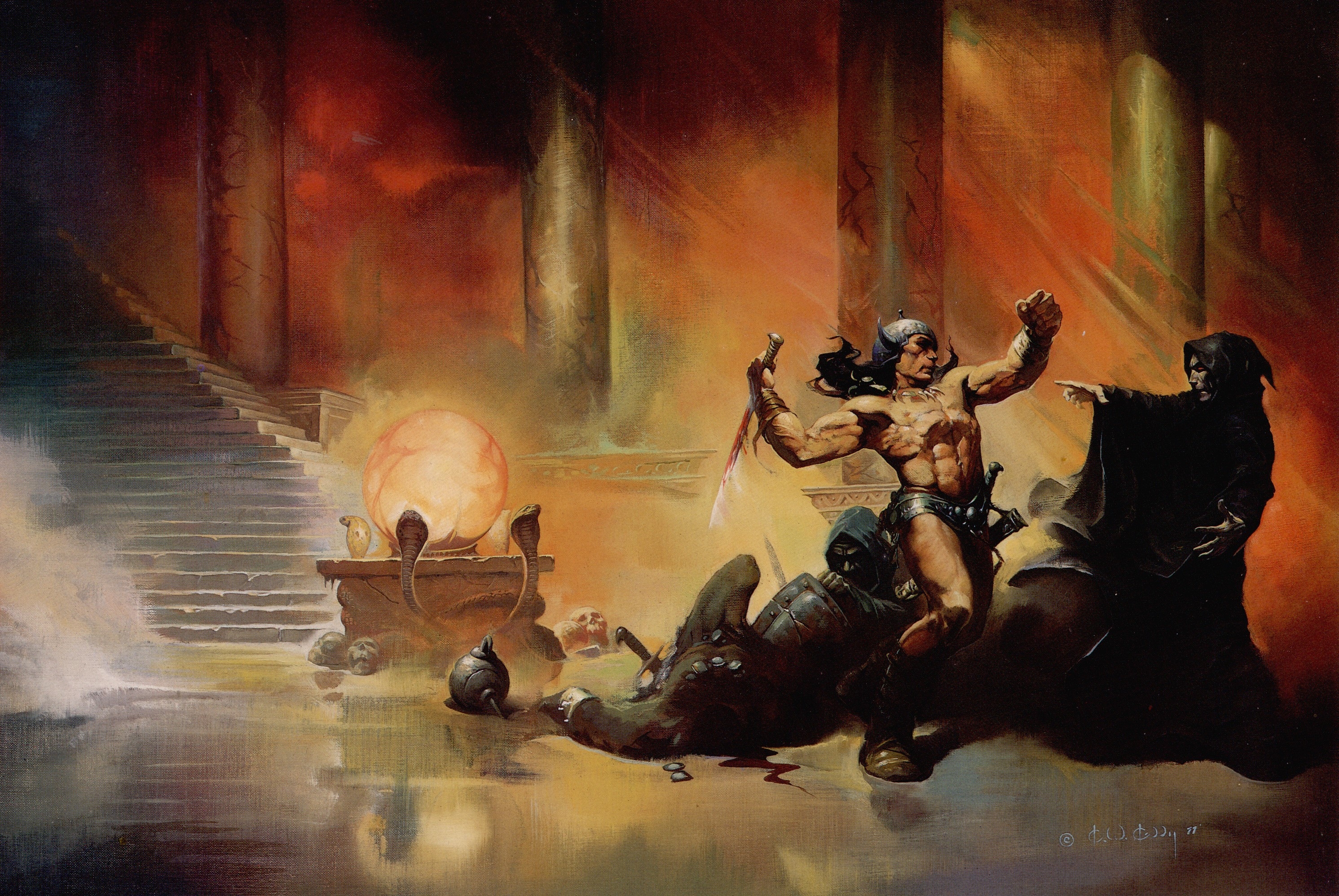
The girl is rescued, but this triggers a final quarrel. For the proud Yasmina has fallen in love with her brutal abductor, who is also her savior, not to mention the avenger of her royal brother’s unholy death. However, despite the flaming passion of her womanly desires, she is first a queen, and can neither abandon her throne to enter Conan’s world, nor would her people allow him, a barbarian, to become her prince consort.
Never has the untamed freedom and red-stained danger of Conan’s world ever seemed more alluring than in the wild boasts Conan makes to conquer a kingdom by the bitter edge of his fearless sword — for the reader knows the heroic barbarian could (and, later in his life, in earlier stories, does) fulfill them.
But, as adumbrated above, Yasmina is akin to Conan in spirit. In the same way he would never betray the trust of a man under him, or a comrade-in-arms by his side, she cannot betray her people, or live for her heart alone.
She lay in his arms looking up at him, and she felt a tug at her spirit, a lawless, reckless urge that matched his own and was by it called into being. But a thousand generations of sovereignship rode heavy upon her.
He threatens to carry her away by force, magnificently scorning all threats or pursuit or promises of reward, when they are interrupted by the arrival of three armies: the first is the Turanian regulars summoned by Kerim Shah back in chapter three, and the second is the Kshatriya loyal to Yasmina, the third is the Afghuli hill-bandits still in hot pursuit of Conan. The Afghulis are trapped in a cul-de-sac by the Turanians, and Conan must allow the princess to go to the Kshatriya, so that she can order them to the rescue. Battle and slaughter commence!
After, both once again a-horse and in command of armies, the couple bid a farewell in a fashion exemplary of Conan and his world. It is worth quoting at length:
“You are the Devi again,” he said, grinning fiercely at the gold-clasped gossamer robe she had donned over her hill-girl attire, and awed not at all by the imposing array of chivalry about him. “I have you to thank for the lives of some three hundred and fifty of my rogues, who are at least convinced that I didn’t betray them. You have put my hands on the reins of conquest again.”
“I still owe you my ransom,” she said, her dark eyes glowing as they swept over him. “Ten thousand pieces of gold I will pay you—”
He made a savage, impatient gesture, shook the blood from his knife and thrust it back in its scabbard, wiping his hands on his mail.
“I will collect your ransom in my own way, at my own time,” he said. “I will collect it in your palace at Ayodhya, and I will come with fifty thousand men to see that the scales are fair.”
She laughed, gathering her reins into her hands. “And I will meet you on the shores of the Jhumda with a hundred thousand!”
His eyes shone with fierce appreciation and admiration, and stepping back, he lifted his hand with a gesture that was like the assumption of kingship, indicating that her road was clear before her.
What else is there to say? Many a Conan fan regard this as his most memorable tale, and I am among them. Nearly every detail of these tales I read in my teen-aged years, half a century or so ago, time has sponged from my memory: but not the scene of the sorcerer-assassin climbing with his broken limbs back up from the abyss to vow eternal vengeance in the name of his beloved awaiting him in hell.
That scene remained with me.
